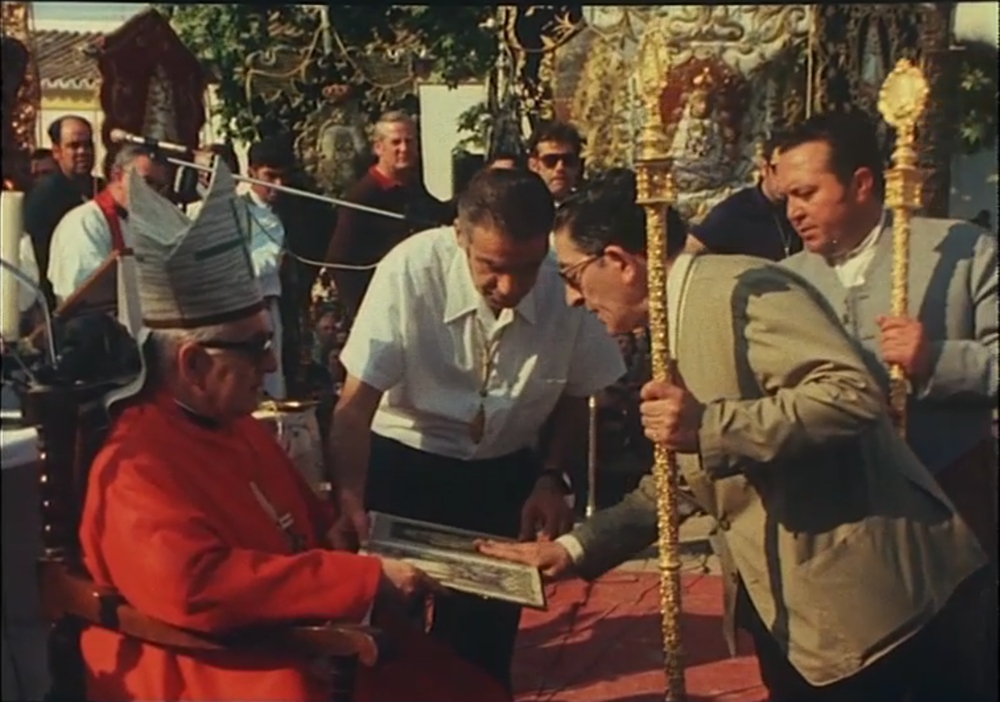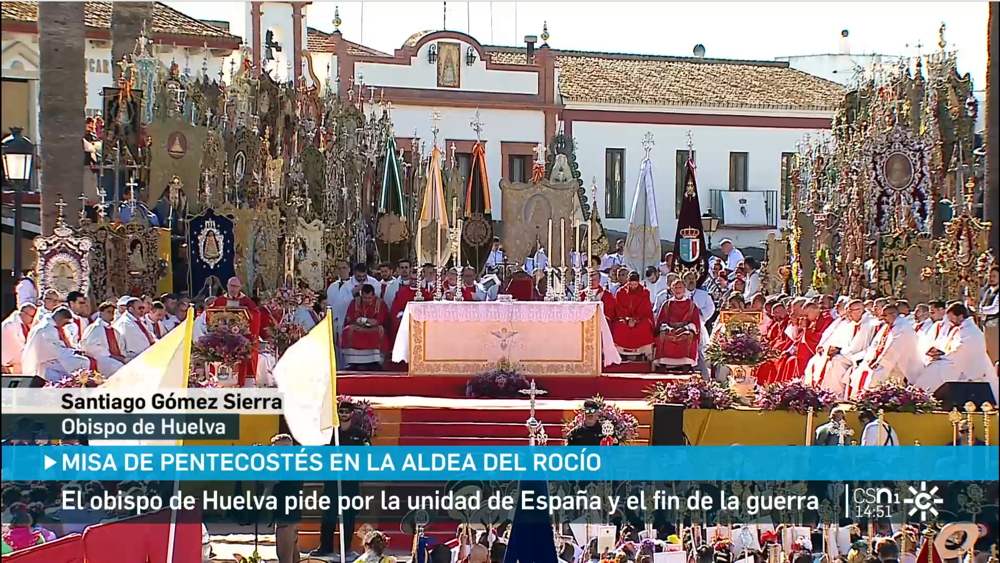Rocío: The Heavy Burden of the Continuity of Power
Top: Still from Rocío (Fernando Ruiz Vergara, 1980) showing the Pentecost Mass during the El Rocío pilgrimage in 1977.
Bottom: Still from a Canal Sur Televisión news broadcast showing the Pentecost Mass during the El Rocío pilgrimage in 2024.
The image on the left is composed of stills from two recordings made in the same space at distant points in time, which seem to merge in a strange specular game. The upper one is from the film Rocío (Fernando Ruiz Vergara, 1980) and was taken in 1977 at one of the masses celebrated during Andalusia’s famous Marian pilgrimage of the same name. In the film, the bishop officiates, surrounded by priests and devotees in front of an audience, sleepy after a long night of celebration and feasting. We could have chosen many other stills from the film, some of which have rarely been shown to the Spanish public during the last four decades.
Rocío is a beautiful and rebellious documentary essay on the pilgrimage, shot in guerrilla mode during Spain’s transition to democracy, confiscated a few months after its release, and judicially censored in 1982 (for more information on the censorship case, see Alvarado 2018). The children of a local landowner named Reales had claimed crimes of slander against the honour of their father. In the film, he was identified as one of the instigators of fascist crimes committed in the village of Almonte (Huelva) in the summer of 1936, shortly after the military uprising that led to the Spanish Civil War. These crimes were never investigated by any authority. If the notion “paranational” can be understood as a device which gives more distinct contours to film practices excluded by national criteria, this tension between the visible and the non-visible can be vividly depicted by the journey of a film that experienced censorship and material mutilation, and conversely challenged political and legal interventions by state authorities.
In the observation of Rocío through a paranational lens, this is not the only tension emerging. It is difficult to avoid the friction, even the paradox, created between a film that addressed and also responded to the stereotypical image of a folkloristic, indolent, plebeian Andalusia and, to some extent, of Spain, and the life of its maker. Fernando Ruiz Vergara was considered an outsider in what should have been his own legitimate milieu. He returned to exile in Portugal after the censorship of Rocío, which remained his only completed film (an account of the unfinished works of Ruiz Vergara can be found in Alvarado and Barquero 2024).
In a first approach, Rocío delves into the creation of the myth behind the figure of the Virgen del Rocío and its connections to other legends – those related to Franco's national Catholicism and the use of the cliché image of Andalusia in the service of the regime. The stereotype was not new and not without contradiction. With the rise of the national film industry, the Andalusian imaginary turned out to be very profitable in economic terms. The scholar of Spanish literature and culture Jo Labanyi indicates a popular model prevalent during the Second Republic – the short period of democratic government since 1931, terminated by the military coup in 1936 – which was opposed and simultaneously instrumentalised by a populist model of Francoism. Labanyi (2003) points out a differential element in the stereotypical image of Andalusia during the Franco era in relation to previous trends. The dictatorship incorporated the popular classes into a different social model, not pluralist and horizontal but totalitarian and vertical, based on hierarchy and an idea of unity imposed by the centralist power.
Rocío exposes the manipulation and abuse by the Catholic Church and how a coalition of religious and economic powers historically took ownership of the land in a region of landless peasants. Simultaneously, the film’s critical angle is suffused with an aesthetic pleasure derived from the mysticism of the pilgrimage and the sensuality of its popular crowds. This fascination with the most ecstatic side of the festivity could have served to disguise the harsh conditions of oppression exercised over the landless and labourers. Rocío instead manages to create a sense of the potential risks of using such images of collective passion. The film respects the fervour of the popular masses as genuine, while revealing how religious and economic powers use it to generate the illusion of a kind of freedom which otherwise does not exist in the daily lives of landless peasants.
This tentative notion of a paranational approach is undergirded by the alternative, or at least ad hoc, methods of financing and producing Rocío, which questioned and challenged the borders dividing Spain and Portugal. Fernando Ruiz Vergara conceived the film in Portugal, where he lived during the 1970s and where he discovered militant cinema in the vibrant atmosphere of the Carnation Revolution. The film’s modest financing was raised through screenings of films banned in Spain, which Ruiz Vergara and his companions organised across the border on Portuguese territory. Rocío’s artistic crew was made up of professionals and a number of amateurs, some Spanish, some Portuguese, who got involved in a film project that promised to materialise new forms of social and political organisation in both countries, close to the end of their long-lasting fascist dictatorships. Rocío is an Iberian film, in that it appeals to a shared Spanish-Portuguese cultural horizon and the utopia of territorial and administrative unity beyond the nation-state. A sort of Iberian Federal Republic.
The image below is a still frame from a news broadcast on Andalusian public television in 2024. The piece reports on the celebration of the traditional Pentecost Mass during the pilgrimage of El Rocío. The headline above the image reads: “The Bishop of Huelva calls for Spanish Unity.” The Spanish national anthem was played and sung during the mass.
With the transition to democracy during the second half of the 1970s, Spain became a non-confessional but not a secular state. After Catholicism had served as the official state confession for decades, state-church relations were not completely dissolved during the transition. The presence of the Catholic Church in Spanish institutions and civil life was maintained – symbolically and more specifically, for example, with the survival of the figure of the military priest. Despite the restructuring of Franco's entire political, social, and judicial apparatus, the dictator's supporters continued to hold posts in the state administration. This continuity of the Francoist regime’s factual powers is palpable in other state establishments, such as the judiciary, which would explain the reasoning behind the sentences issued by the magistrates in Rocío's case.
In Late Fascism, Alberto Toscano notes how “intensely superstructural” current forms of fascism are, for the reactionary zeitgeist in the countries of the capitalist centre does not necessarily entail any fascist movement as such. It is therefore worth asking how superstructural fascism continues to be perpetuated in the symbolic and practical spaces, which figures of power, both ecclesiastical and political, occupy a society's imaginary, with overall connivance. The failure to resolve the crimes denounced in Rocío, and the fact that the censorship of the film remains upheld, are symptoms of how integral such superstructures are to presumably post-fascist, liberal democratic states.

